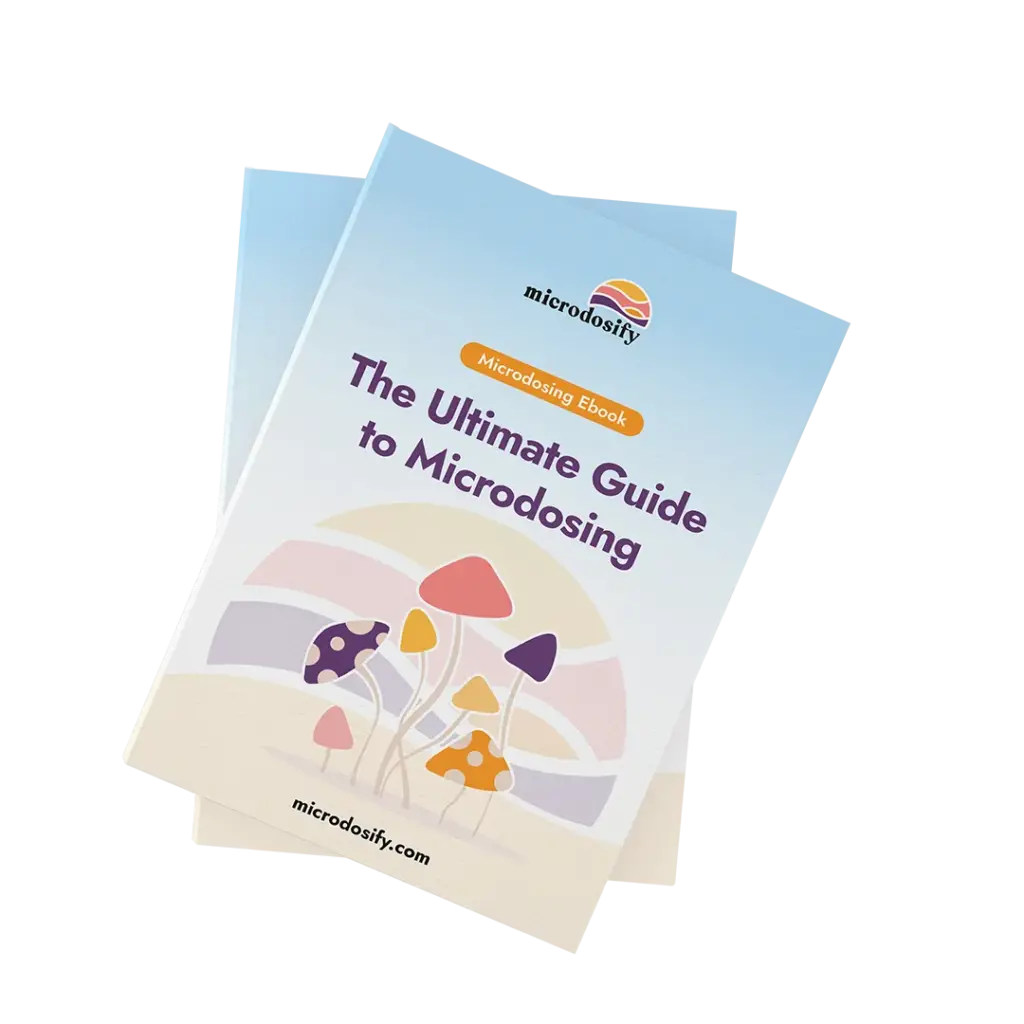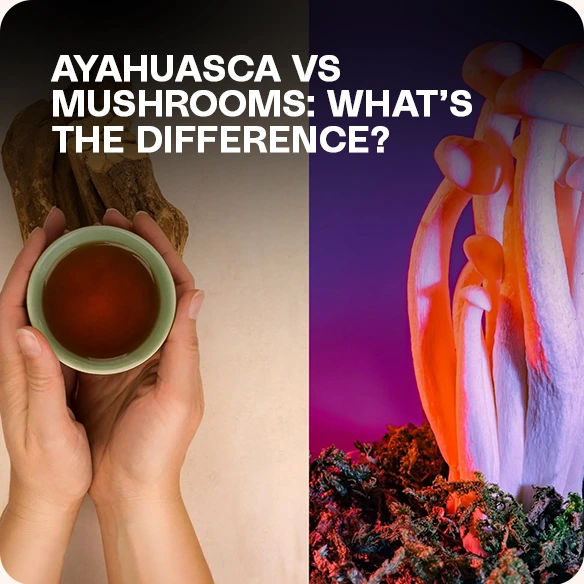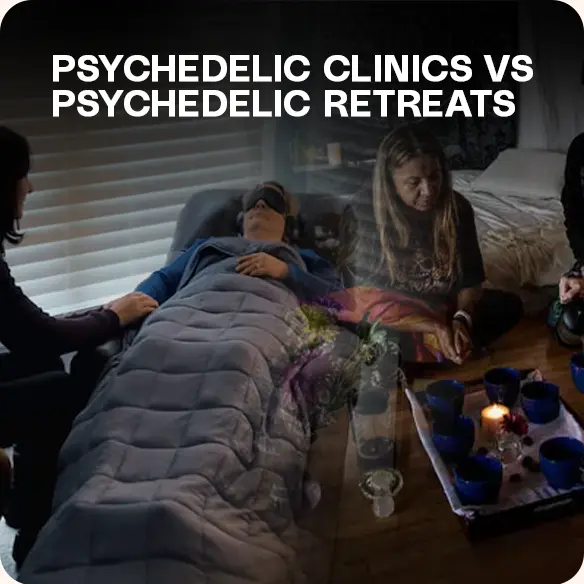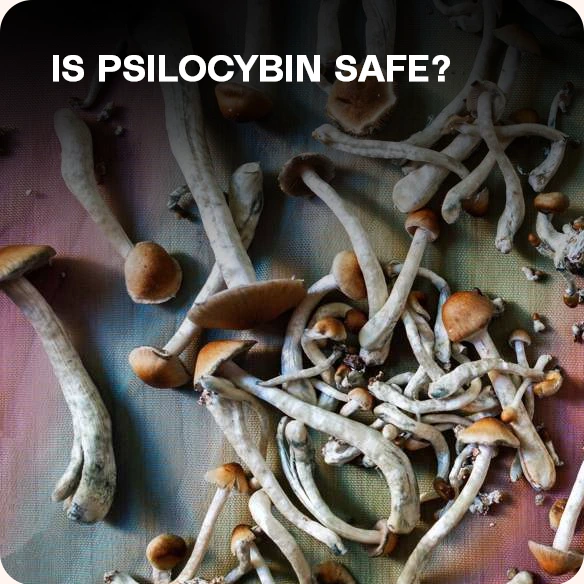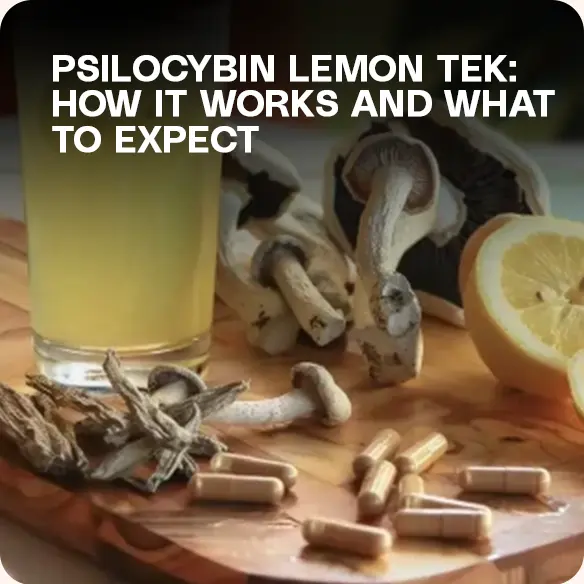Ayahuasca and psilocybin mushrooms are different psychedelic substances with distinct origins, chemical compositions, effects, and traditional uses.
Ayahuasca is a DMT-containing brew from Amazonian plants that lasts 4-6 hours with physical purging, while psilocybin mushrooms are fungi containing psilocybin that last 4-6 hours without typical purging.
Both affect serotonin receptors but produce different subjective experiences and require different preparation protocols.
This comparison addresses the common misconception that ayahuasca is a mushroom. Ayahuasca contains no mushrooms – it’s made from Banisteriopsis caapi vine and DMT-containing plants like Psychotria viridis.
Understanding these differences helps people choose appropriate substances for therapeutic or spiritual purposes.
Key Points
- Chemical Difference: Ayahuasca contains DMT + MAO inhibitors; mushrooms contain psilocybin/psilocin
- Physical Effects: Ayahuasca typically causes purging (vomiting/diarrhea); mushrooms rarely cause purging
- Duration: Both last 4-6 hours, but ayahuasca often feels longer due to intensity
- Traditional Use: Ayahuasca has 1,000+ year Amazonian tradition; mushrooms have Mesoamerican use dating 3,000+ years
- Preparation Requirements: Ayahuasca requires dietary restrictions (no tyramine); mushrooms have minimal dietary restrictions
- Legal Status: Ayahuasca legal in Peru, Brazil, Costa Rica; mushrooms legal in Jamaica, Netherlands (truffles), some US states
- Intensity: Ayahuasca generally considered more intense and physically demanding than mushrooms
Is Ayahuasca a Mushroom?
No, ayahuasca is not a mushroom.
This common misconception likely stems from both substances being plant-based psychedelics used in ceremonial contexts.
Ayahuasca is a liquid brew made by boiling two plants: Banisteriopsis caapi vine and DMT-containing leaves, typically Psychotria viridis or Diplopterys cabrerana.
The confusion may also arise because both substances contain tryptamine compounds.
However, ayahuasca contains DMT (N,N-Dimethyltryptamine) combined with beta-carboline alkaloids that act as MAO inhibitors, while mushrooms contain psilocybin and psilocin.
These are chemically distinct compounds producing related but different effects.
Some people mistakenly refer to “ayahuasca mushrooms” when discussing psilocybin mushrooms used in South American contexts.
This terminology is incorrect – ayahuasca specifically refers to the vine-based brew, never to mushrooms.
Chemical Composition: Ayahuasca vs Psilocybin
Ayahuasca contains DMT plus harmala alkaloids (harmine, harmaline, tetrahydroharmine) from B. caapi vine that inhibit monoamine oxidase enzymes.
This inhibition allows orally consumed DMT to become active, as MAO enzymes normally break down DMT in the digestive system before reaching the brain.
Psilocybin mushrooms contain psilocybin and psilocin as primary active compounds. Psilocybin converts to psilocin in the body, which directly activates serotonin 2A receptors.
No MAO inhibition is necessary for psilocybin to work orally.
| Aspect | Ayahuasca | Psilocybin Mushrooms |
|---|---|---|
| Active Compounds | DMT + MAO inhibitors | Psilocybin + psilocin |
| Source | B. caapi vine + DMT plants | Psilocybe fungi |
| Administration | Brewed liquid, drink | Dried mushrooms, eaten |
| Onset Time | 30-60 minutes | 20-40 minutes |
| Duration | 4-6 hours | 4-6 hours |
How Each Substance Affects the Brain
Both substances primarily activate serotonin 2A receptors, producing altered consciousness, visual effects, and emotional processing.
However, DMT binds more strongly to serotonin receptors than psilocin, contributing to ayahuasca’s reportedly more intense visionary experiences.
MAO inhibitors in ayahuasca also increase serotonin, norepinephrine, and dopamine levels beyond DMT’s effects alone.
This additional neurotransmitter activity may explain ayahuasca’s unique emotional and physical intensity compared to mushrooms.
What Are the Physical Effects Differences?
Ayahuasca typically causes significant physical purging including vomiting and diarrhea, considered part of the traditional healing process.
Purging usually occurs 1-2 hours into experiences and is viewed as releasing negative energy or emotional blockages in indigenous traditions.
Psilocybin mushrooms rarely cause purging in most users.
Common physical effects include nausea (especially during onset), body temperature fluctuations, pupil dilation, and increased heart rate. The nausea usually passes within the first hour without vomiting.
Physical Comfort During Experiences
Ayahuasca experiences are generally more physically challenging.
Besides purging, participants report body aches, trembling, temperature swings, and general physical discomfort. Ceremonies provide buckets for purging and facilitators assist with physical needs.
Mushroom experiences allow more physical comfort and mobility.
Users can walk, change positions, and move freely without the immediate purging concerns present with ayahuasca.
This makes mushrooms more manageable for people with physical health concerns.
Experience Quality: Ayahuasca vs Magic Mushrooms
Ayahuasca experiences are often described as more visionary, introspective, and emotionally intense than psilocybin. Users report detailed visions, entity encounters, life reviews, and profound emotional releases.
The experience feels more “directed” or purposeful, possibly influenced by ceremonial context and MAO inhibitor effects.
Mushroom experiences vary widely by dose, setting, and individual factors.
Lower doses (1-2 grams) produce gentle mood elevation and visual enhancements.
Higher doses (3.5+ grams) create profound experiences comparable to ayahuasca but with different phenomenological character – often described as more “organic,” playful, or nature-connected.
Subjective Experience Characteristics
Ayahuasca users frequently describe experiences as “having a purpose” or “being taught lessons” by the medicine.
Visions often contain specific symbolic content related to personal issues. The experience can feel like undergoing surgery or deep cleaning on psychological and spiritual levels.
Mushroom experiences often feel more exploratory and open-ended.
Users describe merging with nature, experiencing universal love, or dissolving ego boundaries. The experience quality is often gentler and more euphoric than ayahuasca, though high doses can be equally profound.
Cultural and Traditional Differences
Ayahuasca has continuous use in Amazonian indigenous cultures for over 1,000 years, with some archaeological evidence suggesting older origins. Shipibo, Ashaninka, and other tribes maintain living traditions with specific ceremonial protocols, songs (icaros), and dietary practices (dieta).
Psilocybin mushrooms have documented use in Mesoamerican cultures dating back 3,000+ years. Aztec and Maya civilizations used mushrooms called teonanácatl (“flesh of the gods”) in religious ceremonies.
Mazatec traditions in Oaxaca, Mexico preserve continuous ceremonial use.
| Tradition Aspect | Ayahuasca | Psilocybin Mushrooms |
|---|---|---|
| Primary Region | Amazon basin (Peru, Brazil, Ecuador) | Mesoamerica (Mexico, Guatemala) |
| Historical Depth | 1,000+ years documented | 3,000+ years documented |
| Modern Preservation | Active indigenous practice | Limited indigenous practice |
| Ceremonial Structure | Highly structured, multi-hour rituals | Varies by tradition |
Preparation Requirements: Ayahuasca vs Mushrooms
Ayahuasca requires strict dietary preparation (dieta) for 2-7 days before ceremonies.
Participants must avoid tyramine-rich foods including aged cheeses, cured meats, fermented products, alcohol, and certain medications. MAO inhibitors in ayahuasca create dangerous interactions with tyramine, potentially causing hypertensive crises.
Additional ayahuasca restrictions include sexual abstinence, avoiding spicy foods, limiting salt and sugar, and abstaining from recreational drugs for weeks before ceremonies.
These restrictions prepare the body and demonstrate commitment to the healing process.
Psilocybin mushrooms require minimal dietary preparation.
Users typically fast 2-4 hours before consumption to reduce nausea. No specific food restrictions exist, though heavy meals before consumption may increase stomach discomfort. Medication interactions still require attention, particularly SSRIs.
Mental and Spiritual Preparation
Both substances benefit from intention-setting, meditation, and psychological readiness.
Ayahuasca traditions emphasize longer preparation periods with specific spiritual practices, while mushroom preparation can be more flexible depending on ceremonial context versus personal use.
Retreat settings for both substances typically include group preparation sessions, education about what to expect, and guidance on setting intentions.
Solo experiences require more self-directed preparation through reading, journaling, and creating safe environments.
Which Is Safer: Ayahuasca or Magic Mushrooms?
Psilocybin mushrooms generally present fewer medical risks than ayahuasca for most people.
The primary mushroom contraindications involve psychiatric conditions (psychosis, schizophrenia family history) and medication interactions (SSRIs, MAOIs).
Cardiovascular risks are minimal for healthy individuals.
Ayahuasca carries additional risks due to MAO inhibitor interactions.
The tyramine interaction can cause dangerous blood pressure spikes if dietary restrictions are ignored.
Cardiac stress from increased heart rate and blood pressure poses risks for people with heart conditions. The DMT component also presents stronger cardiovascular demands than psilocybin.
| Safety Factor | Ayahuasca | Psilocybin Mushrooms |
|---|---|---|
| Dietary Restrictions | Strict (tyramine foods dangerous) | Minimal (light fasting recommended) |
| Medication Interactions | Many (SSRIs, stimulants, etc.) | Fewer (mainly SSRIs reduce effects) |
| Cardiac Risk | Higher (MAOIs + DMT effects) | Lower (minimal cardiovascular stress) |
| Physical Discomfort | High (purging expected) | Low to moderate (occasional nausea) |
| Psychological Intensity | Very high | Dose-dependent (moderate to high) |
Death Risk Comparison
Deaths directly attributable to ayahuasca or psilocybin toxicity are extremely rare.
Most fatalities involve pre-existing conditions, medication interactions, or accidents during experiences.
Ayahuasca-related deaths occasionally occur in retreat settings from cardiac events in unscreened participants or interactions with undisclosed medications.
Psilocybin mushroom deaths are exceptionally rare, typically involving accidents (falls, drowning) during experiences rather than pharmacological toxicity.
The LD50 (lethal dose) of psilocybin is extremely high relative to active doses, making overdose nearly impossible.
Which Should I Choose: Ayahuasca or Mushrooms?
Choose ayahuasca if you want traditional ceremonial structure, are comfortable with physical purging, and seek intense introspective work.
Ayahuasca suits people who appreciate ritual, can meet dietary restrictions, and prefer longer preparation commitments. The medicine works best in traditional settings with experienced facilitators.
Choose mushrooms if you prefer physical comfort, want more flexibility in setting and dose, or have cardiovascular concerns making ayahuasca riskier.
Mushrooms allow graduated experiences from mild (1-2g) to profound (3.5g+), letting you find appropriate intensity levels.
They work in both ceremonial and therapeutic contexts.
Therapeutic Applications
Clinical research on psilocybin for depression, anxiety, and PTSD has progressed further than ayahuasca research. Multiple Phase 2 and 3 trials demonstrate psilocybin efficacy, with FDA breakthrough therapy designation.
This research base makes mushrooms more accessible in emerging legal therapeutic frameworks.
Ayahuasca research shows promise for addiction, depression, and PTSD but remains earlier-stage with fewer controlled trials. Traditional healing contexts provide extensive anecdotal evidence, but Western medical systems require controlled study data for acceptance.
Can You Combine Ayahuasca and Shrooms?
Combining ayahuasca and shrooms is not recommended without expert guidance.
Both substances activate serotonin systems intensely, and combination increases unpredictability and intensity beyond what most people can safely integrate.
The MAO inhibitors in ayahuasca also potentiate psilocybin effects.
Some experienced practitioners use psilocybin mushrooms in ayahuasca brew formulations, replacing or supplementing DMT-containing plants.
These combinations require expert preparation and dosing knowledge to avoid overwhelming experiences or dangerous serotonin levels.
Timing matters if using both substances separately. Most practitioners recommend 2-4 weeks minimum between ayahuasca and mushroom experiences, allowing full integration and metabolic recovery.
Legal Status: Where Can You Use Each?
Ayahuasca remains legal for religious or traditional use in Brazil, Peru, Costa Rica, and several other South American countries.
Some churches in the United States (Santo Daime, União do Vegetal) have religious exemptions for ceremonial ayahuasca use. General ayahuasca use outside religious contexts remains illegal under US federal law.
Psilocybin mushrooms are legal in Jamaica (all uses), Netherlands (truffles only), and increasingly in US jurisdictions. Oregon and Colorado created licensed psilocybin service frameworks.
Multiple cities decriminalized possession including Denver, Oakland, Santa Cruz, Ann Arbor, and Washington DC.
International retreat tourism remains the primary legal access method for both substances, with Peru and Costa Rica leading for ayahuasca, and Jamaica and Netherlands for psilocybin.
Cost Comparison: Ayahuasca vs Mushroom Retreats
Ayahuasca retreats typically cost $1,500-3,500 for 7-14 days in South American locations. P
eruvian jungle retreats offer the lowest prices ($1,500-2,500) while Costa Rican programs cost more ($2,500-4,500). Programs include multiple ceremonies (4-8 typically), accommodation, meals, and integration support.
Psilocybin mushroom retreats cost $2,500-6,000 for 5-7 days. Jamaica retreats average $3,500-5,500, Netherlands programs $2,000-4,000, and US legal programs (Oregon/Colorado) $2,500-5,000. Higher costs reflect more expensive locations and recently established legal frameworks.
Frequently Asked Questions
Is ayahuasca stronger than mushrooms?
Ayahuasca is generally considered more intense than typical mushroom doses due to DMT potency and MAO inhibitor effects.
However, high mushroom doses (5+ grams) can match or exceed ayahuasca intensity. Comparing strength directly is difficult because experiences differ qualitatively, not just quantitatively.
Do ayahuasca and mushrooms show up on drug tests?
Standard drug tests do not screen for DMT or psilocybin. Specialized tests can detect these compounds but are rarely used outside forensic or research contexts. Both substances clear the body within 24-48 hours, making detection windows very short even with specialized testing.
Which is better for beginners: ayahuasca or mushrooms?
Mushrooms are generally better for beginners due to lower intensity at moderate doses and easier physical experience.
Starting with 1-2 grams of mushrooms provides introduction to psychedelic states without overwhelming effects. Ayahuasca’s purging and intensity make it challenging for first-time psychedelic users.
Can I microdose ayahuasca like mushrooms?
Ayahuasca microdosing is possible but less common and more complex than mushroom microdosing. The MAO inhibitors in ayahuasca create dietary restrictions even at microdoses.
Most people who microdose psychedelics choose psilocybin or LSD for convenience and established protocols.
How long should I wait between ayahuasca and mushroom experiences?
Wait at least 2-4 weeks between ayahuasca and mushroom experiences to allow full integration and prevent tolerance. Both substances create cross-tolerance at serotonin receptors.
More importantly, psychological integration requires time before undertaking another profound experience.
